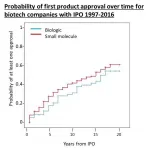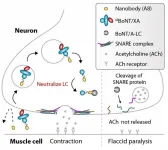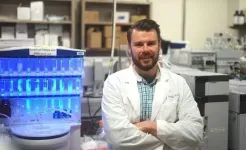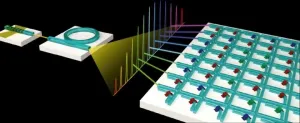CytoDel announces successful intra-neuronal antibody delivery without a viral vector
Studies show Cyto-111 enables delivery of antibodies to previously inaccessible intraneuronal targets without the need for a viral vector or transfection. Supports the development of new approaches to treat multiple neurological diseases
2021-01-06
(Press-News.org) New York City, January 6, 2021 - CytoDel, Inc. ("CytoDel" or "the Company"), a privately-held corporation, today announces the publication of preclinical data on the Company's lead product, Cyto-111, in the peer-reviewed journal, Science Translational Medicine. The complete text of the article titled, "Neuronal Delivery of Antibodies has Therapeutic Effects in Animal Models of Botulism," can be found here.
Cyto-111 was conceived, expressed and purified in the laboratory of Konstantin Ichtchenko, Ph.D., NYU Grossman School of Medicine, Department of Biochemistry and Molecular Pharmacology, who was a principal investigator in the study, which was supported by grants from the National Institute of Allergy and Infectious Diseases (NIAID), a division of the National Institute of Health (NIH).
Based on Dr. Ichtchenko's hypothesis that the C1ad delivery vehicle previously reported could be used to transport therapeutic proteins into the neuronal cytosol, researchers led by Dr. Ichtchenko developed and tested a potential treatment for botulism based on intracellular inhibition of the BoNT subtype A1 light chain metalloprotease (LC/A1). The main objective of the study was to develop and test a post-symptomatic botulism antidote that could rescue symptomatic animals challenged with a lethal dose of BoNT. Following in vitro validation of therapeutic mechanisms, efficacy studies were conducted in mice, guinea pigs and rhesus macaque monkeys.
The study showed that a precision biotherapeutic consisting of a function-blocking single domain antibody (sdAb; B8) cargo fused to the C1ad delivery vehicle (forming B8C1ad or Cyto-111) can enter neurons and protect SNARE proteins by inhibiting LC/A1 catalytic activity in situ. Post-symptomatic administration of B8C1ad produced antidotal rescue in mice, guinea pigs, and non-human primates following a lethal botulism challenge.
According to the study's authors, "The flexibility of the C1ad molecular delivery platform offers several advantages for the rapid generation of new treatments for neurological disorders. In particular, the presynaptic localization of LC suggests this therapeutic approach will be particularly effective in treating synaptopathies involving active zone proteins. Indeed, the platform can be efficiently redirected towards other protein targets by replacing or adding single domain antibodies or other protein moieties."
The study concluded that, "These data demonstrate that atoxic BoNT derivatives can be harnessed to deliver therapeutic protein moieties to the neuronal cytoplasm where they bind and neutralize intracellular targets in experimental models. The generalizability of this platform might enable delivery of antibodies and other protein-based therapeutics to previously inaccessible intraneuronal targets."
"This is a landmark study in converting the power of lethal botulinum neurotoxins into therapies. The approach used to turn botulinum toxin into a kind of Trojan horse that delivers a cargo into neurons has enormous potential for future drug development," noted Thomas C. Südhof, M.D., Professor in the School of Medicine in the Department of Molecular and Cellular Physiology, and in Neurology, Psychiatry and Behavioral Sciences at Stanford University, a 2013 Nobel Prize winner in Physiology/ Medicine, a Howard Hughes Medical Institute investigator, and Chair of CytoDel's Scientific Advisory Board.
"We are delighted to have these data published in a well-respected peer-reviewed journal as they represent the culmination of many years of research with the intent of finding a solution to effectively treat weaponized botulinum toxins. Importantly, these groundbreaking data are the result of the efforts of researchers from a number of renowned institutions including NYU Grossman School of Medicine, Tufts University Center for Translational Medicine, and the US Army Medical Research Institute for Chemical Defense, without whose hard work and dedication this achievement would not have been possible," commented Phillip A. Band, Ph.D., Research Professor in the Departments of Orthopedic Surgery, Biochemistry and Molecular Pharmacology, NYU Grossman School of Medicine, and co-inventor, co-founder and Chief Executive Officer of CytoDel.
"Not only did these studies show that Cyto-111 can be an antidote to botulinum toxins, but they demonstrate the generalizability of the molecular vehicle in three different species to safely and effectively deliver functional antibodies to the inside of neurons via a non-viral mechanism. This is a particularly exciting breakthrough as no other labs have previously inactivated a pathogen inside of neurons, which are inaccessible to standard antibodies. This achievement opens the door for the development of new approaches to treat multiple neurological diseases," added Dr. Band.
INFORMATION:
About Botulinum Neurotoxin
Botulinum neurotoxin (BoNT) is considered a Tier 1 weapon of mass destruction. BoNT has no odor or taste, a single gram is sufficient to kill 1 million humans via ingestion or inhalation, and currently there are no treatments to reverse symptoms. All currently available treatments for botulism are antibody products which can only neutralize toxin in the systemic circulation. Once the toxin has entered the neurons controlling respiration, generally 24-72 hours after exposure depending on the dose, antibody-based products become ineffective. Standard antibodies cannot access toxin already inside neurons, and thus BAT® (Botulism AntiToxin, a product of Emergent BioSolutions), the only FDA-approved antitoxin, is only effective while the toxin remains in the circulation.
About Cyto-111
Cyto-111 uses CytoDel's Intraneuronal Delivery Platform to deliver an antibody to the inside of BoNT-intoxicated neurons, thereby allowing rescue after the toxin has entered neurons and is causing symptoms. This "Trojan horse" approach uses an inactivated recombinant BoNT derivative to carry the antibody to the inside of BoNT-intoxicated neurons. Cyto-111 can uniquely reverse symptoms because it can deliver its antibody to toxin already inside the neuron. In biodefense scenarios, this significantly extends the period post-exposure during which treatment can reverse symptoms and can save lives by minimizing the need for long-term artificial respiration. As a therapeutic for naturally occurring botulism, Cyto-111 extends the therapeutic window beyond the current 48-hour limit during which BAT has proven to be effective.
About CytoDel
CytoDel is a privately held biopharmaceutical company that uses the tools of 21st century molecular biology to produce recombinant derivatives of botulinum neurotoxin customized to specific applications. The Company's proprietary technology allows CytoDel to manipulate the BoNT molecule to develop next generation BoNT products and a drug delivery vehicle that can deliver therapeutic molecules to the inside of neurons. CytoDel's lead program is focused on developing BioBetter BoNT pharmaceuticals, offering improved safety margin and effectiveness outcomes for the treatment of large muscles and muscle groups. A second program utilizes intraneuronal delivery for Biodefense, and CytoDel is also developing programs for the treatment of nervous system disorders and chronic pain. For more information visit http://www.cytodel.com.
* Both Drs. Ichtchenko and Band from NYU Grossman School of Medicine have financial interests in CytoDel and Dr. Band serves on its management team. These arrangements are being managed in accordance with the policies and practices of NYU Langone Health.
Contact:
Allison Moulard
Email: allison@cytodel.com
Phone: 510 823 0501
Anne Marie Fields
Email: amfields912@gmail.com
Phone: 201-315-8118
ELSE PRESS RELEASES FROM THIS DATE:
2021-01-06
A large scale study from Bentley University of the biotechnology companies that completed Initial Public Offerings from 1997-2016 estimates that 78% of these companies are associated with products that reach phase 3 trials and 52% are associated with new product approvals. The article, titled "Late-stage product development and approvals by biotechnology companies after IPO, 1997-2016," shows that these emerging, public biotechnology companies continue to have a role in initiating new product development, but are no longer distinctively focused on novel, biological products.
The new report from the Center for Integration of Science and Industry at Bentley University, published in Clinical Therapeutics, studied the 319 biotechnology ...
2021-01-06
E. coli food poisoning is one of the worst food poisonings, causing bloody diarrhea and kidney damage. But all the carnage might be just an unintended side effect, researchers from UConn Health report in the 27 November issue of Science Immunology. Their findings might lead to more effective treatments for this potentially deadly disease.
Escherichia coli are a diverse group of bacteria that often live in animal guts. Many types of E. coli never make us sick; other varieties can cause traveler's diarrhea. But swallowing even a few cells of the type of E. coli that makes Shiga toxin can make us very, very ill. Shiga toxin damages blood vessels in the intestines, causing bloody diarrhea. If ...
2021-01-06
Taking advantage of the chemical properties of botulism toxins, two teams of researchers have fashioned non-toxic versions of these compounds that can deliver therapeutic antibodies to treat botulism, a potentially fatal disease with few approved treatments. The research, which was conducted in mice, guinea pigs, and nonhuman primates, suggests that the toxin derivatives could one day offer a platform to quickly treat established cases of botulism and target hard-to-reach molecules within neurons. Botulism manifests due to bacterial toxins called botulinum neurotoxins (BoNTs), which are the most potent toxins known ...
2021-01-06
The pandemic has exacerbated isolation and fears for one very vulnerable group of Americans: the 4.3 million older adults with cognitive impairment who live alone.
As the coronavirus continues to claim more lives and upend others, researchers led by UC San Francisco are calling for tailored services and support for older adults living alone with memory issues, who are experiencing extreme isolation, and are exposed to misinformation about the virus and barriers to accessing medical care.
In their qualitative study, researchers interviewed 24 San Francisco Bay Area residents whose average age was 82. Of these, 17 were women, and 13 were either monolingual Spanish-speakers ...
2021-01-06
LA JOLLA--New data suggest that nearly all COVID-19 survivors have the immune cells necessary to fight re-infection.
The findings, based on analyses of blood samples from 188 COVID-19 patients, suggest that responses to the novel coronavirus, SARS-CoV-2, from all major players in the "adaptive" immune system, which learns to fight specific pathogens, can last for at least eight months after the onset of symptoms from the initial infection.
"Our data suggest that the immune response is there--and it stays," LJI Professor Alessandro Sette, Dr. Biol. Sci., who co-led the study with LJI Professor Shane Crotty, ...
2021-01-06
Drug-resistant bacteria could lead to more deaths than cancer by 2050, according to a report commissioned by the United Kingdom in 2014 and jointly supported by the U.K. government and the Wellcome Trust. In an effort to reduce the potential infection-caused 10 million deaths worldwide, Penn State researcher Scott Medina has developed a peptide, or small protein, that can target a specific pathogen without damaging the good bacteria that bolsters the immune system.
Medina, an assistant professor of biomedical engineering, led the team who published its results Jan. 4 in Nature Biomedical Engineering.
"One of the best protective mechanisms we have to prevent infection are beneficial bacteria that inhabit our bodies, known as commensals," ...
2021-01-06
Ikoma, Japan - Ultrasmall integrated circuits have revolutionized mobile phones, home appliances, cars, and other everyday technologies. To further miniaturize electronics and enable advanced functions, circuits must be reliably fabricated in three dimensions. Achieving ultrafine 3D shape control by etching into silicon is difficult because even atomic-scale damage reduces device performance. Researchers at Nara Institute of Science and Technology (NAIST) report, in a new study seen in Crystal Growth and Design, silicon etched to adopt the shape of atomically smooth pyramids. Coating these silicon pyramids with a thin layer of iron imparts ...
2021-01-06
ITHACA, N.Y. - For more than seven years, a mysterious wasting disease has nearly killed off sea star populations around the world. Some of these species stand at the brink of extinction.
New Cornell University-led research suggests that starfish, victims of sea star wasting disease (SSWD), may actually be in respiratory distress - literally "drowning" in their own environment - as elevated microbial activity derived from nearby organic matter and warm ocean temperatures rob the creatures of their ability to breathe.
"As humans, we breathe, we ventilate, we bring air into our lungs ...
2021-01-06
In the digital age, data traffic is growing at an exponential rate. The demands on computing power for applications in artificial intelligence such as pattern and speech recognition in particular, or for self-driving vehicles, often exceeds the capacities of conventional computer processors. Working together with an international team, researchers at the University of Münster are developing new approaches and process architectures which can cope with these tasks extremely efficient. They have now shown that so-called photonic processors, with which data is processed by means of light, can process information much more rapidly and in parallel - something ...
2021-01-06
Young adults ages 18-24 years old in the U.S. say that porn is their most helpful source of information about how to have sex, according to a new study led by a Boston University School of Public Health (BUSPH) researcher published in the journal Archives of Sexual Behavior.
In the nationally representative survey, a quarter of young adults said porn was their most helpful source of information about how to have sex. Slightly less than a quarter said sexual partners were the most helpful source, and fewer pointed to friends, parents, media, or healthcare professionals. However, female respondents were much more likely than male respondents to report that their partners ...
LAST 30 PRESS RELEASES:
[Press-News.org] CytoDel announces successful intra-neuronal antibody delivery without a viral vector
Studies show Cyto-111 enables delivery of antibodies to previously inaccessible intraneuronal targets without the need for a viral vector or transfection. Supports the development of new approaches to treat multiple neurological diseases



